Agriculture - 1 | SSC CGL Tier 2 - Study Material, Online Tests, Previous Year PDF Download
| Table of contents |

|
| Introduction |

|
| Primary Activities |

|
| Types of Agriculture in Various Parts of the World |

|
| Introduction to Indian Agriculture |

|
| Crops |

|
| Food Grains |

|
Introduction
Agriculture encompasses the scientific, artistic, and practical aspects of cultivating plants and livestock. It stands as a pivotal development in the evolution of sedentary human civilization, marking the transition to a lifestyle where the farming of domesticated species resulted in food surpluses, ultimately facilitating the establishment of urban centers.
Primary Activities
- Humans Engage in different activities to exploit natural resources and the most ancient of them are Primary activities.
- Primary activities are directly dependent on the environment and some of these activities are:
Gathering and hunting:
- These are the oldest economic activities known.
- Gathering is practiced in regions with harsh climatic conditions.
- It often involves primitive societies, who extract both plants and animals to satisfy their needs for food, shelter and clothing.
- The main features of Gathering and Hunting activities are:
- Low Capital / Skill Investment
- Low Yield Per Person
- No Surplus in production
- Gathering is practised in the following areas of the world:
- Northern Canada, northern Eurasia and southern Chile (High Altitude Areas)
- Low latitude zones such as the Amazon Basin, tropical Africa, Northern fringe of Australia and the interior parts of Southeast Asia.
Nomadic Herding or Pastoral Nomadism:
- Nomadic herding or pastoral nomadism is a primitive subsistence activity, in which the herders rely on animals for food, clothing, shelter, tools and transport.
- They move from one place to another along with their livestock, depending on the amount and quality of pastures and water, thus there is an irregular pattern of movement.
- It is different from Transhumance in which there is a fixed seasonal pattern of movement.
- Nomadic pastoralism is commonly practised in regions with little arable land, typically in the developing world.
- Of the estimated 30–40 million nomadic pastoralists worldwide, most are found in central Asia and Northern and western regions of Africa, some parts of southern Africa and Tundra regions.
- In the Himalayas, Gujjars, Bakarwals, Gaddis and Bhotiyas are nomadic pastoralists who practice transhumance.
Types of Agriculture in Various Parts of the World
Commercial Livestock Rearing:
Characterized by a more organized and capital-intensive approach compared to Nomadic pastoralism.
Typically conducted in permanent ranches.
Emphasizes scientific processing and packaging of products such as meat, wool, hides, and skin.
Products are exported to various global markets.
Focus on breeding, genetic improvement, disease control, and healthcare for the animals.
Prominent in countries like New Zealand, Australia, Argentina, Uruguay, and the United States of America.
Ranches refers to the large stock farms, usually fenced in, where animals are bred and reared on a commercial scale. They are found especially in the United States.
Primary Subsistence Agriculture
- Subsistence agriculture is one in which the farming areas consume all, or nearly so, of the products locally grown.
Subsistence agriculture
- Primitive Subsistence Agriculture
- Intensive Subsistence Agriculture
Primitive Subsistence Agriculture
- This agriculture is also known as Shifting Cultivation.
- It is widely practised by many tribes in the tropics, especially in Africa, south and Central America and south East Asia.
- When the vegetation is cleared by fire, and the ashes add to the fertility of the soil, it is called slash and burn agriculture.
- After sometime (3 to 5 years) the soil loses its fertility and the farmer shifts to other parts and clears other patches of the forest for cultivation.
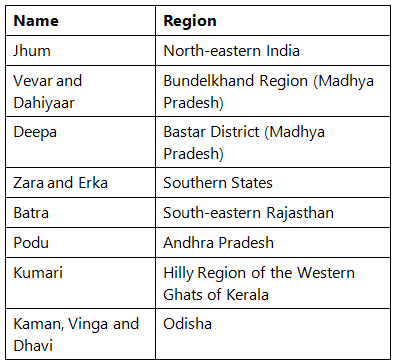
Intensive Subsistence Agriculture
- In this type of farming system, crops are grown mainly for local consumption. If there is a surplus, then it is sold in the market.
- This type of farming is largely found in densely populated regions of monsoon Asia.
- Basically, there are two types of intensive subsistence agriculture.
- One is dominated by wet paddy and
- Another is dominated by crops such as sorghum, soybeans, sugarcane, maize, and vegetables.
- Areas of Intensive Subsistence Farming are: Tonkin Delta (Vietnam), lower Menem (Thailand); lower Irrawaddy (Myanmar); and the Ganga-Brahmaputra Delta, Eastern Coastal Plains (India).
Mediterranean Agriculture
- It is practised within the Mediterranean climatic region where winter is wet and summer is dry.
- Farming is intensive, highly specialised and varied in the kind of crops raised.
- Many crops such as wheat, barley and vegetables are raised for domestic consumption, while others like citrus fruits, olives and grapes are grown mainly for export.
- That’s why this region is also called Orchard Lands of the World and it is the heart of the world’s wine industry. This region is famous around the world for the production of citrus fruits and grapes in the world.
Viticulture or grape cultivation is a speciality of the Mediterranean region. Best quality wines in the world with distinctive flavours are produced from high quality grapes in various countries of this region. The inferior grapes are dried into raisins and currants. This region also produces olives and figs. The advantage of Mediterranean agriculture is that more valuable crops such as fruits and vegetables are grown in winters when there is great demand in European and North American markets.
Plantation Agriculture
- This type of farming has developed in parts of Asia, Africa and Latin America, where the influence of the Europeans have been important during the colonial period.
- Though practiced over a rather small area, this type of farming is quite important in terms of its commercial value.
- Tea, coffee, rubber and oil palm are the major products of this type of farming. Most of the plantations were developed to provide some of the important tropical crops to the European markets.
- Important plantation regions:
- Tea gardens in India and Sri Lanka
- Banana and sugar plantations in the West Indies
- Coffee plantations in Brazil
- Rubber in Malaysia
- This is a highly capital-intensive farming and most of the crops are tree crops.
Extensive Commercial Grain Cultivation
- This type of agriculture system is mainly practiced in the Eurasian steppes in regions of chernozem soil, Canadian and American Prairies, the Pampas of Argentina, the Veld of South Africa, the Australian Downs and the Canterbury Plain of New Zealand.
- The main characteristics of this type of agriculture are:
- highly mechanized cultivation
- farms are very large
- predominance of wheat
- low yield per acre but yield per capita is high.
Mixed Farming
- This type of agricultural system is found in the highly developed parts of the world: north-western Europe, eastern North America, Russia, Ukraine, and the temperate latitudes of parts of the southern continents.
- Farming is very intensive and sometimes highly specialized.
- Traditionally, farmers have practised a mixed economy by raising animals and growing crops on the same farm.
- Mixed farming is characterised by high capital expenditure on farm machinery and building, extensive use of chemical fertilisers and green manures and also by the skill and expertise of the farmers.
Dairy Farming
- Dairy is the most advanced and efficient type of rearing of milch animals. It is highly capital intensive. Animal sheds, storage facilities for fodder, feeding and milking machines add to the cost of dairy farming. Special emphasis is laid on cattle breeding, health care and veterinary services.
- It is highly labour intensive as it involves rigorous care in feeding and milching. There is no off season during the year as in the case of crop raising.
- It is practised mainly near urban and industrial centres which provide neighbourhood markets for fresh milk and dairy products. The development of transportation, refrigeration, pasteurisation and other preservation processes have increased the duration of shortage of various dairy products.
Market Gardening and Horticulture
- It is practised mainly in the same region as that of mixed farming that consists of cultivation of vegetables, fruit and flowers solely for the urban market.
- It is well-developed in the densely populated industrial districts of north-western Europe (Britain, Denmark, Netherlands, Belgium, and Germany) and in North-Eastern USA.
The regions where farmers specialise in vegetables only, the farming is known as truck farming. The distance of truck farms from the market is governed by the distance that a truck can cover overnight, hence the name truck farming.
Factory Farming
- Factory farming is a method of mass food production in which animals are kept in very confined areas in order to get the best possible profit.
- This farming is particularly concentrated in Developed countries like USA, European nations, Australia etc.
Co-operative Farming
- A group of farmers form a co-operative society by pooling in their resources voluntarily for more efficient and profitable farming. Individual farms remain intact and farming is a matter of cooperative initiative.
- Co-operative societies help farmers, to procure all important inputs of farming, sell the products at the most favourable terms and help in processing of quality products at cheaper rates.
- Co-operative movement originated over a century ago and has been successful in many western European countries like Denmark, Netherlands, Belgium, Sweden, Italy etc. In Denmark, the movement has been so successful that practically every farmer is a member of a co-operative.
Collective Farming
- The basic principle behind this type of farming is based on social ownership of the means of production and collective labour.
- Collective farming or the model of Kolkhoz was introduced in the erstwhile Soviet Union to improve upon the inefficiency of the previous methods of agriculture and to boost agricultural production for self-sufficiency.
- The farmers used to pool in all their resources like land, livestock and labour. However, they were allowed to retain very small plots to grow crops in order to meet their daily requirements.
- Yearly targets were set by the government and the produce was also sold to the state at fixed prices.
- Produce in excess of the fixed amount was distributed among the members or sold in the market. The farmers had to pay taxes on the farm produce, hired machinery etc.
- Members were paid according to the nature of the work allotted to them by the farm management.
- Exceptional work was rewarded in cash or kind. This type of farming was introduced in the former Soviet Union under the socialist regime which was adopted by the socialist countries. After its collapse, these have already been modified.
Introduction to Indian Agriculture
- India is an agricultural economy where 49% of the people depend directly or indirectly on agriculture.
- Net sown area still accounts for about 47% of the total land area of India.
- In India, over 80 per cent of water is used in irrigation. Of the net sown area of around 140 million hectares (Mn ha), close to half (68.4 Mn ha) is irrigated (2019)
- Major states like Uttar Pradesh, Bihar, Rajasthan, Madhya Pradesh, Odisha among others are still majorly dependent on Agriculture.
GDP compositions in 2018-19 are as follows (ES2020)
- Agriculture (16.5%)
- Services (55.3%)
- Industry (28.6%)
Facts/Data related to Agriculture sector
- Share of agriculture and allied sectors in Gross Value Addition (GVA) has declined from 18.2 percent in 2014-15 to 16.5 percent in 2019-20.
- The Agriculture, Forestry and Fishing sector is estimated to grow by 2.8 percent in 2019-20 as compared to growth of 2.9 percent in 2018-19.
- According to the 2010-11 Agricultural Census, 47% of landholdings had become less than half a hectare in size. These holdings are too small to support a family of five so that many farmers now seek alternative sources of income – NITI 3-year action agenda
- About 80 percent of farmers own less than two hectare.
Salient Features of an Indian Agriculture
Relies on an unreliable and erratic monsoon, affecting around 60 percent of the agriculture.
India's vast relief, diverse climate, and soil conditions contribute to the cultivation of a wide variety of crops.
Encompasses the growth of tropical, subtropical, and temperate crops across different geographical areas.
Dominated by food crops, covering approximately two-thirds of the total cropped area.
Serves as the backbone of the rural economy.
Plays a critical role in ensuring food security for the nation.
Faces challenges such as poor electricity, storage, water, credit, and marketing infrastructure.
Supports allied sectors and activities like cattle and poultry farming.
Witnesses significant involvement of women in the Indian agriculture sector.
Characterized by inadequate mechanization and insufficient agricultural research and extension services.
Exhibits a fragmented nature in terms of agricultural holding.
Productivity of Agriculture
- Productivity of Agriculture is defined as the number of crops produced per unit land.
- Productivity levels in Indian agriculture are very low as compared to the productivity levels of other countries – China, USA etc.
- Like in 2018, average productivity in India was 3075 Kg/ha while world average was 3200kg/ha.
- Fertiliser use, irrigation and rainfall cause significant variation in productivity
- Productivity in the regions of Green revolution are certainly higher than other areas. Other high productivity regions are Tamil Nadu, Kerala, West Bengal and Maharashtra.
- The productivity in Gangetic plain is reducing because of Land bifurcation leading to reduced size of land holdings.
- Key issues affecting agricultural productivity include the decreasing sizes of agricultural land holdings, continued dependence on the monsoon, inadequate access to irrigation, imbalanced use of soil nutrients resulting in loss of fertility of soil, uneven access to modern technology in different parts of the country, lack of access to formal agricultural credit, limited procurement of food grains by government agencies, and failure to provide remunerative prices to farmers.
Cropping Intensity
- The ratio of the gross cropped area to the net sown area.
- As the land is cropped multiple times, the cropping intensity increases.
- It depends on factors like climate, demand of crops, availability of irrigation and other inputs etc.
Boosting productivity
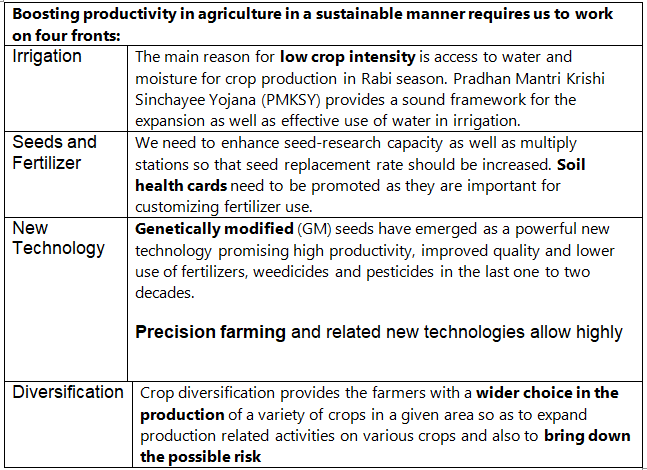 Crops
Crops
- A crop is a plant or animal product that can be grown and harvested extensively for profit or subsistence.
Basic facts
- India produced 284.83 Mn tons of food grains in 2018.
- India is the world’s largest producer of milk, pulses and jute.
- India occupies a leading position in global trade of agricultural products, agricultural export basket accounts for a little over 2.15 per cent of the world agricultural trade.
Crop classification based upon the type of produce

Crop classification based upon climate

Crop classification based on growing season
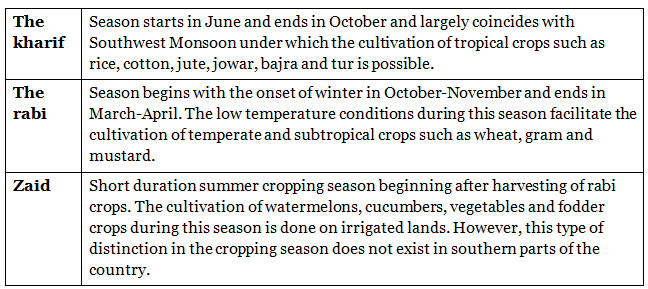
Food Grains
Food grains are dominant crops in all parts of the country whether they have subsistence or commercial agricultural economy.
Food grains
- Cereals
- Pulses
Cereals
- The cereals occupy about 54 per cent of the total cropped area in India.
- India produces a variety of cereals, which are classified as fine grains (rice, wheat) and coarse grains (jowar, bajra, maize, ragi), etc.
Pulses
- Pulses are a very important ingredient of vegetarian food as these are rich sources of proteins.
- These are legume crops which increase the natural fertility of soils through nitrogen fixation.
- India is a leading producer of pulses and accounts for about one-fifth of the total production of pulses in the world.
- The cultivation of pulses in the country is largely concentrated in the drylands of Deccan and central plateaus and north-western parts of the country.
- Pulses occupy about 11 per cent of the total cropped area in the country. Being the rainfed crops of drylands, the yields of pulses are low and fluctuate from year to year.
- Gram and tur are the main pulses cultivated in India.
In India, the dryland farming is largely confined to the regions having annual rainfall less than 75 cm. These regions grow hardy and drought resistant crops such as ragi, bajra, moong, gram and fodder crops.
Major Food Crops in India
1. RICE
- Rice is preferred staple food in southern and north-eastern India.
- India produced 42 mmt in 2018-19, 2nd highest production in world after China.
- India had the highest export volume of rice worldwide, at 9.8 million metric tons as of 2018/2019.
- West Bengal is the largest producer followed by Uttar Pradesh.
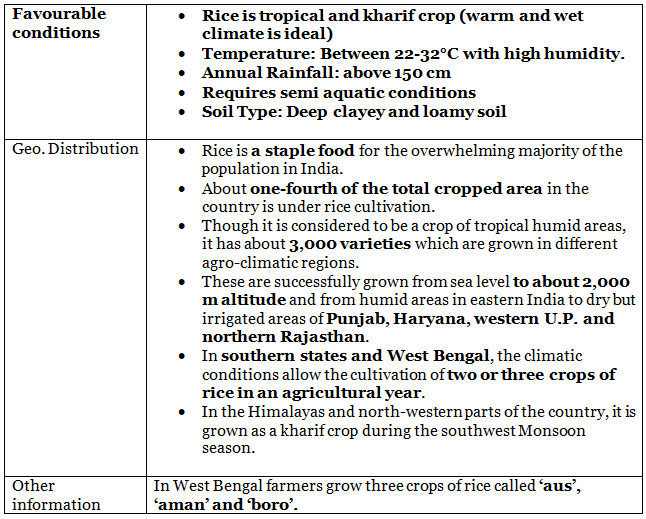
Farmers in West Bengal are experimenting with the Pokkali variety of rice to tide over a crisis-like situation created by severe seawater incursion into paddy fields in the Sundarbans (owing to Cyclone Amphan). Vyttila-11 varieties of pokkali seedlings were brought from Kerala. The pokkali variety of rice is known for its saltwater resistance and flourishes in the rice paddies of coastal Alappuzha, Ernakulam and Thrissur districts of Kerala.
Kuttanad Below Sea Level Farming System of Kerala is Globally Important Agricultural Heritage Systems (GIAHS) site in India.
2. WHEAT
Wheat stands as the preferred staple food in the northern and north-western regions of India.
India's wheat production reached a record 20 million tonnes in the crop year 2018-19 (July-June), marking a 1.3% increase from the previous year.
India holds the position of the third-largest wheat producer globally, trailing behind the European Union and China.
Uttar Pradesh takes the lead as the largest wheat producer in India, followed by Punjab and Haryana.

3. MILLETS
- Temperature: Between 27-32°C
- Rainfall: Around 50-100 cm.
- Soil Type: Can be grown in inferior alluvial or loamy soil because they are less sensitive to soil deficiencies
- India is the largest producer followed by Niger.
- Entirely grown under subsistence farming
- Grown for fodder crops
- Very nutritious and affordable, important for Nutrition security but least preferred given low remunerative outcomes.
- Millets include jawar, bajara, ragi etc.
Jawar
- Jawar – 3th most important crop after rice and wheat
- Jowar has high nutritional value.
- Jowar is grown in both Kharif and Rabi seasons. It is sown in both kharif and rabi seasons in southern states. But it is a kharif crop in northern India where it is mostly grown as a fodder crop
- Suitable for rainfed areas of dryland farming.
- Require around 30 cm rainfall – dry situation
- The coarse cereals together occupy about 16.50 per cent of total cropped area in the country. Among these, jowar or sorghum alone accounts for about 5.3 per cent of total cropped area.
- It is the main food crop in semi-arid areas of central and southern India.
- Maharashtra alone produces more than half of the total jowar production of the country.
- Other leading producer states of jowar are Karnataka, Madhya Pradesh, Andhra Pradesh and Telangana.
Bajra
- Bajara Is the second most important
- Grown in the areas of 40-50 cm of annual rainfall.
- Bajra is sown in hot and dry climatic conditions in north-western and western parts of the country.
- It is a hardy crop which resists frequent dry spells and drought in this region.
- It is cultivated alone as well as part of mixed cropping.
- This coarse cereal occupies about 5.2 per cent of the total cropped area in the country.
- Leading producers of bajra are the states of Maharashtra, Gujarat, Uttar Pradesh, Rajasthan and Haryana.
- Being a rainfed crop, the yield level of this crop is low in Rajasthan and fluctuates a lot from year to year.
- Yield of this crop has increased during recent years in Haryana and Gujarat due to introduction of drought resistant varieties and expansion of irrigation under it.
Maize
- Maize is rainfed kharif
- Maize is a food as well as fodder crop grown under semi-arid climatic conditions and over inferior soils.
- This crop occupies only about 3.6 per cent of total cropped area.
- India is the Sixth Largest producer of the crop in the world.
- Maize cultivation is not concentrated in any specific region. It is sown all over India except eastern and north-eastern regions.
- The leading producers of maize are the states of Madhya Pradesh, Andhra Pradesh, Telangana, Karnataka, Rajasthan and Uttar Pradesh.
- Yield level of maize is higher than other coarse cereals. It is high in southern states and declines towards central parts.
4. OILSEEDS
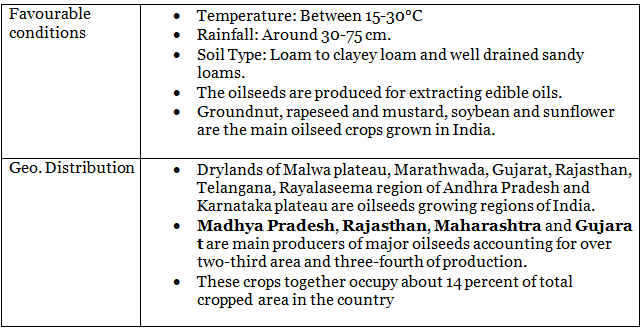
Groundnut
- It is largely a rainfed kharif crop of drylands. But in southern India, it is cultivated during rabi season as well.
- It is a tropical crop that requires 50-75 cm of rainfall.
- It covers about 3.6 per cent of the total cropped area in the country.
- Gujarat, Tamil Nadu, Telangana, Andhra Pradesh, Karnataka and Maharashtra are the leading producers.
- Yield of groundnut is comparatively high in Tamil Nadu where it is partly irrigated. But its yield is low in Telangana, Andhra Pradesh and Karnataka.
Rapeseed and Mustard
- Rapeseed and mustard comprise several oilseeds as rai, sarson, toria and taramira.
- These are subtropical crops cultivated during rabi season in north-western and central parts of India.
- These are frost sensitive crops and their yields fluctuate from year to year.
- But with the expansion of irrigation and improvement in seed technology, their yields have improved and stabilised to some extent.
- About two-third of the cultivated area under these crops is irrigated. These oilseeds together occupy only 2.5 per cent of the total cropped area in the country.
- Rajasthan contributes about one-third production while other leading producers are Uttar Pradesh, Haryana, West Bengal and Madhya Pradesh. Yields of these crops are comparatively high in Haryana and Rajasthan.
Soyabean
- Soyabean is mostly grown in Madhya Pradesh and Maharashtra.
- These two states together produce about 90 per cent of total output of soyabean in the country.
Sunflower
- Sunflower cultivation is concentrated in
Karnataka, Andhra Pradesh, Telangana and adjoining areas of Maharashtra. - It is a minor crop in northern parts of the country where its yield is high due to
Sesamum
- India accounts for one-third of the world production and is the largest producer.
- Since it is a rainfed kharif crop the production fluctuates greatly with time.
- Sesamum is produced in almost all parts of the country.
- West Bengal is the largest producing state (one-third of the total production of India). The other major producers are Gujarat, Rajasthan, Maharashtra, etc.
|
1335 videos|1436 docs|834 tests
|
FAQs on Agriculture - 1 - SSC CGL Tier 2 - Study Material, Online Tests, Previous Year
| 1. What are the primary activities in the field of agriculture? |  |
| 2. What are the different types of agriculture found in various parts of the world? |  |
| 3. What is Indian agriculture known for? |  |
| 4. What are the major crops grown in Indian agriculture? |  |
| 5. What are some challenges faced by Indian agriculture? |  |















